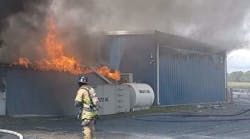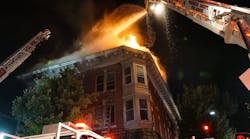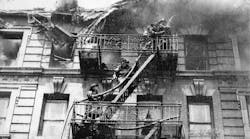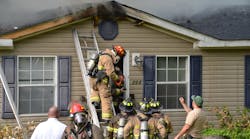Companies from the Rochester, N.Y. Fire Department were dispatched to a report of a woman in the Genesee River near the Main Street Bridge early in the afternoon of Jan. 14.
With temperatures in the mid 20s, time was not on their side if they indeed had a person in the frigid river waters.
The crew of Engine 17 began a survey of the area along the bridge and adjoining river banks. A victim was spotted in the river near the west bank.
This area of the river which bisects the city has vertical walls which make gaining access to the water level even more challenging. Company officer Captain John Taillie notified the balance of the assignment of their location and assumed command of the incident.
Battalion Chief Richard Yackel later assumed command, and Taillie was in charge of rescue operations.
He instructed his crew members to bring the extension ladder from their apparatus which was used as an access device for rescuers to reach the victim. It was part of a preplanned effort to address the challenges of the vertical walls in this section of the river.
Members had practiced these techniques during previous drills in this section of the river as part of the department’s water rescue response training.
While the ladder was being deployed, Firefighters Doug King and Rich Brongo of Rescue 11 had donned their swift water rescue gear in preparation for a potential entry into the river.
The equipment consisted of a thermal lining to help protect the rescuers from the frigid conditions, a swift water rescue dry suit, personal flotation device, boots, helmet and gloves. They were tethered to safety lines attached to the breakaway device on their PFDs and descended the ladder to the victim.
Upon making contact with the victim, they were able to position her on a small ledge along the walls base just above the water line.
They requested a litter be lowered so they could begin preparations to remove her from the river.
Additional companies on the assignment were simultaneously preparing the rigging systems to assist in the raising of the litter once the victim was packaged Truck 10’s crew led by Lt. Jim Hartman established anchor points for the mainline which utilized a pre-rigged RPMS system set up in a 3 to 1 configuration for the lift.
A second anchor system was established for the tandem prusik belay system. Both the main and belay lines were attached to the bridle of the litter and lowered by hand to the rescuers below. (The system had a rigging rack ready in the event it was needed for lowering however, due to the relatively short lower of the empty litter the decisions was made to control it by hand in the interest of expediting the operation).
Engine 1 was special called to the scene for manpower and assisted with tending the tag lines for the two rescuers in the water and providing the haul team for the mainline.
When the victim was secured in the litter, Lt. Shaun Murray from Rescue 11 took over edge control and coordinated the raise.
Once the victim had been brought to the safe side of the rail, the hauling systems were detached and the litter was handed over to waiting EMS providers from Rural Metro Ambulance, the city’s contract ambulance provider.
The two rescuers were brought up the ladder to safe ground bringing the emergency component of the incident to a close.
It should be noted that during this incident the balance of the water rescue response, the crew of Quint and Midi 6 which are the lead company for the water rescue team, were positioned down river at the next cross street over the river.
This is a standard procedure when rescuers are in situations that may dictate them making entry into the water. Having a safety team down river fully outfitted for entry and shore based rescue efforts provides a critical safety component in the overall operation.
Once all equipment was picked up and placed ready for service the companies were able to return to quarters.
The positive outcome of this incident can be attributed to a number of things:
· Pre-planning of a known target hazard.
· The commitment of the department to properly equip and train its members for the hazards they face during specialized rescue incidents of this nature.
· Effective use of the incident command system allowing for an organized and structured operation.






